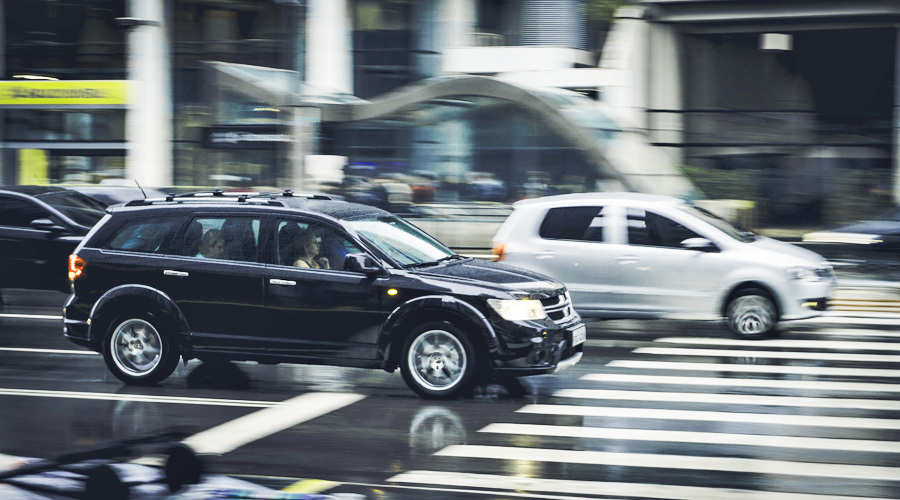
Vehicles are the primary way people get around from place to place in the modern age. Every state's Department of Transportation needs to monitor the average daily traffic volume on various roads to prioritize road repairs and make decisions about road safety.
This traffic volume data is available online and can be useful in several different applications. Businesses can choose the best retail location based on a traffic volume map. It can also help provide information on movement patterns throughout the city.
Here's how to measure traffic volume and the 10 different types of technology you can use.
1. Manual Counter
Manually counting vehicles that drive on the street is the oldest way to measure traffic volume. Instead of tallying on a piece of paper, however, you can use an electronic handheld counter.
With this method of collecting traffic data, you usually count vehicles over a certain period of time within a single day, such as during rush hour.
While this isn't the best way to calculate average daily traffic volume, it is the most affordable and easiest method.
2. Video AI
Video AI has improved significantly in the past few years. Video cameras can do much more than monitoring the exterior of your building. Now, they can track vehicle and pedestrian traffic outside your front door and record license plate numbers.
This is one of the best ways for business owners to get the average daily traffic volume of your street and protect your building all at once.
3. Pneumatic Road Tube
Pneumatic road tubes work by sending a burst of air pressure through a rubber tube when a car passed over it. This pressure closes off an air switch that triggers an attached counter software.
The data logger can tell vehicle direction based on which tube sends the air pressure first. If more than one car crosses it at the same time, it could send a misreading.
As such, these are best used on lower-volume roads instead of highways.
4. Piezoelectric Sensor
Much like a pneumatic road tube, a piezoelectric sensor collects data when a car passes over it. These sensors are installed into a groove in the road, and cars passing over them generate a voltage signal. A counting device is attached nearby, and data can be collected locally or by modem.
5. Inductive Loop
An inductive loop is another sensor that counts vehicles passing above it. As the magnetic field of a car passes over the inductive loop, it generates signals that are then recorded.
It works well on intersections and freeways as a result. However, poor pavement conditions and water penetration can cause low performance.
6. Magnetic Sensor
If you're wondering how to measure traffic volume more efficiently, consider a magnetic sensor. These sensors detect changes in the Earth's magnetic field when a metallic object passes by.
It can detect all the different parts of the vehicle passing over it. In some cases, these sensors can record traffic information like a vehicle's classification.
7. Acoustic Detector
Instead of physically altering the street to install a sensor, you can try an acoustic detector. These sensors are mounted on a pole pointing towards the road, and they detect vehicles based on the sound of them passing by.
While these wouldn't work as well on busy roads, they can be installed around corners where cars naturally slow down.
8. Passive Infrared
One way to monitor the average daily traffic volume is through their heat signatures. Passive infrared devices can detect the heat given off by a vehicle. Every time one passes by, it gets counted.
Generally speaking, road surface temperature changes aren't measured. However, each device can only monitor up to two lanes maximum.
You can purchase passive infrared sensors that are attached discreetly and monitor roads, entrances, and more. While they may have a limited range, infrared sensors work well when visibility is otherwise low.
9. Doppler Sensors
Doppler microwave sensors detect moving vehicles from radiation reflected off of them. These devices emit low-energy microwave radiation and can register changes in the signal.
While these tend not to be affected by weather patterns and cover multiple lanes, they don't work with stopped vehicles. Make sure they're not installed in a location where cars may park or stop.
Some devices you purchase come with a wide range of settings for the microwave, including sensitivity adjustment and the exclusion of humans. You can also purchase a doppler sensor that doesn't require concrete installation.
10. Radar Sensors
Radar sensors work a lot like doppler sensors. They send out radio waves and measure how long it takes for the signal to return. It not only calculates the existence of a vehicle but how far away it was.
As a result, radar sensors work great for collecting traffic volume data for larger roads.
Newer models of radar sensors can classify different vehicles on the road and detect as many as 256 different vehicles simultaneously. They use 3D and 4D measurements to collect traffic data on vehicle size, range, and speed.
How to Measure Traffic Volume Effectively
Whether you're interested in measuring traffic volume for data collection purposes or improving your business, you need the right tech. All of these different technologies excel in one area and lack in others.
Infrared devices are effective at shorter ranges. Radar sensors work much more broadly. Be sure you're purchasing the right one for your applications.
Contact us today to learn more about how our sensors can help you, or check out our installation guides.
